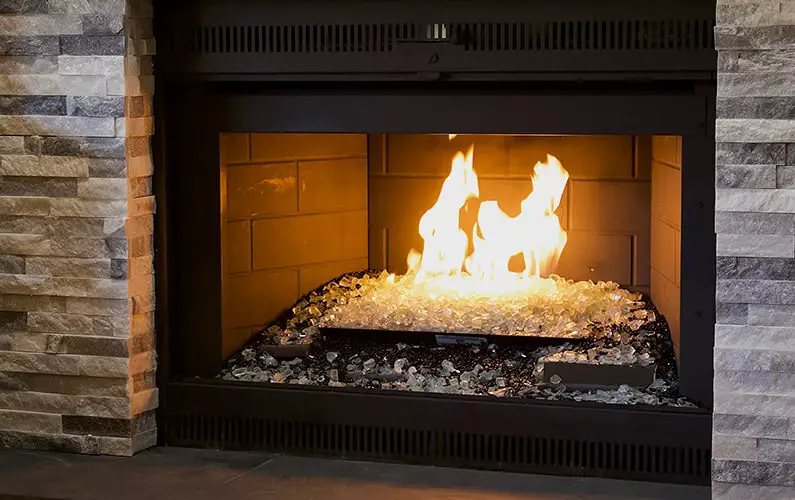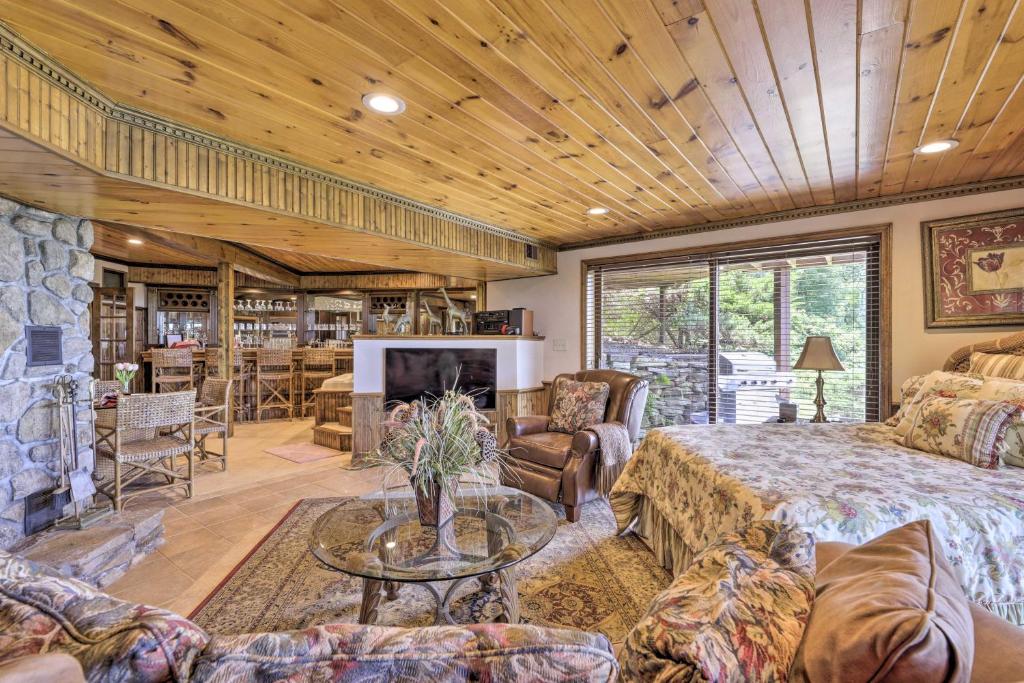A gas fireplace operates by pulling fresh air for combustion through one pipe and expelling exhaust fumes through another pipe. This system ensures efficient burning with minimal indoor air pollution.
Gas fireplaces comprise incombustible logs over gas vents, emitting radiant and convected heat through glass doors. The design mimics a traditional wood-burning fireplace while offering a cleaner and more convenient heating solution for modern homes. With easy controls for flame height and fan operation, gas fireplaces provide a hassle-free way to enjoy the warmth and ambiance of a fire without the need for traditional chimney systems.
Ideal for heating a room and creating a cozy atmosphere, gas fireplaces have become a popular choice for homeowners seeking efficient and stylish heating options.


Credit: www.amazon.com
Understanding Gas Fireplaces
Gas fireplaces offer a convenient and efficient way to add warmth and ambiance to a space. Understanding how these fireplaces work can enhance your enjoyment and ensure their proper maintenance.
Basics Of Gas Fireplaces
Gas fireplaces utilize natural gas or propane as fuel sources to generate flames. These flames are enclosed within a firebox and produce heat that warms the surrounding area.
Components Of A Gas Fireplace
- Thermocouple
- Thermopile
- Valve
- Firebox
How Gas Fireplaces Work
A gas fireplace operates through a simple mechanism that involves the combustion of gas to produce heat and flames. The gas, usually natural gas or propane, is ignited within the fireplace unit, creating a controlled fire that emits warmth and visual appeal.
The ventilation system of a gas fireplace is crucial for safety and efficiency. It typically includes a vent pipe that expels combustion byproducts like carbon monoxide outside the home. This ensures proper air circulation and prevents the buildup of harmful gases indoors.
Gas fireplaces provide both radiant and convective heat. Radiant heat is emitted directly from the flames to warm nearby objects, while convective heat is created as air circulates around the fireplace, heating the room more evenly.
Advantages And Disadvantages
Gas fireplaces offer both advantages and disadvantages, making it important for homeowners to carefully consider their options before making a decision. Understanding the benefits and drawbacks of gas fireplaces can help in making an informed choice for heating and aesthetic needs.
Benefits Of Gas Fireplaces
Gas fireplaces have several advantages that make them an attractive option for homeowners. Some of the benefits include:
- Convenient to use and easy to operate
- Efficient heating source with instant warmth
- Low maintenance and no need for wood storage or cleaning up ash
- Reduces indoor air pollution as they produce less smoke and particles
- Can be operated with a remote control for added convenience
Drawbacks Of Gas Fireplaces
While gas fireplaces have many advantages, there are also some drawbacks that should be considered, including:
- Expense: Gas fuel can be more expensive than wood logs
- Carbon monoxide: Gas fireplaces in poor condition may produce excess carbon monoxide during combustion
- Visual limitations: Gas fireplaces may have a different firebox visual as special logs are used
- Dependency on electricity for operation in some models
- Complex installation and requirement for ventilation systems in some cases
Operating A Gas Fireplace
Gas fireplaces operate by using gas as fuel, and they are ignited by a switch or remote control. The flame height can be adjusted, and a fan can distribute heat. Gas fireplaces do not always require a traditional chimney, but may need a ventilation system for safety.
Using Remote Controls
One of the convenient features of a gas fireplace is the ability to control it using a remote control. With just a push of a button, you can turn on and off the fireplace, adjust the flame height, and even control the fan operation.
Using the remote control is as simple as pointing it towards the fireplace and pressing the desired button. The remote control sends a signal to the fireplace, instructing it to carry out the command.
Adjusting Flame Height
The flame height of a gas fireplace can be easily adjusted according to your preference. Most gas fireplaces have a control knob that allows you to increase or decrease the flame height. Turning the knob clockwise will increase the flame height, while turning it counterclockwise will decrease it.
It is important to note that adjusting the flame height can affect the amount of heat produced by the fireplace. If you are solely using the fireplace for decorative purposes, you may prefer a lower flame height to create a more subtle and relaxed ambiance. On the other hand, if you are looking for maximum heat output, a higher flame height would be ideal.
Keep in mind that each gas fireplace model may have different instructions for adjusting flame height, so it’s always a good idea to refer to the manufacturer’s manual for specific guidance.
Maintenance And Safety
When it comes to enjoying the warmth and ambiance of a gas fireplace, it is important to prioritize maintenance and safety. By taking proper care of your gas fireplace and adhering to safety considerations, you can ensure its longevity and the well-being of your home and loved ones.
Chimney Requirements
Unlike traditional wood-burning fireplaces, a gas fireplace does not necessarily require a chimney. However, a proper ventilation system is essential. It is recommended to have a Class A Flue or B-vent in place to ensure the safe removal of combustion gases. A Class A flue, known for its durability and safety, provides the highest quality ventilation for your gas fireplace.
Safety Considerations
When operating a gas fireplace, it is crucial to keep safety in mind. Here are some important safety considerations to follow:
- Regular Inspections: Schedule regular inspections by a certified professional to ensure that your gas fireplace is in good working condition and free from any potential hazards.
- Proper Ventilation: Ensure that the ventilation system, such as the Class A Flue or B-vent, is installed correctly and functioning efficiently to prevent the build-up of harmful gases like carbon monoxide.
- Keep flammable objects away: Maintain a safe distance between flammable objects such as curtains, furniture, or rugs and the gas fireplace to avoid any fire hazards.
- Install carbon monoxide detectors: To provide an extra layer of safety, install carbon monoxide detectors near your gas fireplace and in other areas of your home to detect any presence of this odorless and potentially dangerous gas.
- Proper Use: Follow the manufacturer’s guidelines for operating your gas fireplace. Avoid modifying or tampering with the gas fireplace components as it can compromise safety.
By adhering to proper maintenance and safety practices, you can enjoy the beauty and warmth of your gas fireplace with peace of mind. Remember, when it comes to the safety of your home and loved ones, it’s better to be proactive and prioritize maintenance.

Credit: www.booking.com
:strip_icc()/bhg-white-brick-fireplace-bedroom-wood-black-chair-11092019_TASHIMA_BHG_Farewell-11_MasterBR_Overall-4311-055af6d96aa64ff4bea565f379117b42.jpg)
Credit: www.bhg.com
Frequently Asked Questions Of How Does A Gas Fireplace Work
How Do I Operate My Gas Fireplace?
To operate your gas fireplace, use the remote control or wall switch to turn it on and adjust flame height and fan settings.
What Are The Disadvantages Of A Gas Fireplace?
Disadvantages of gas fireplaces include higher fuel costs than wood and potential carbon monoxide emissions from poorly maintained units.
Does A Gas Fireplace Heat The House?
Yes, a gas fireplace can effectively heat a house. It radiates warmth and can be a valuable heat source.
Does A Gas Fireplace Need A Chimney?
A gas fireplace does not necessarily need a chimney in the traditional sense. However, it does require a ventilation system, such as a Class A Flue or B-vent, to safely remove exhaust fumes. It can also utilize a special b-vent pipe for ventilation.
How Does A Gas Fireplace Work?
A gas fireplace works by igniting natural gas or propane fuel, creating flames and heat. The fire is controlled by a control panel or remote, and the heat is distributed through vents.
Conclusion
Gas fireplaces operate through a combination of gas fuel, ventilation systems, and combustion techniques. Understanding the components and functionality provides insight into their operation and benefits. The versatility and convenience make gas fireplaces a popular choice for many households seeking efficient heating solutions.